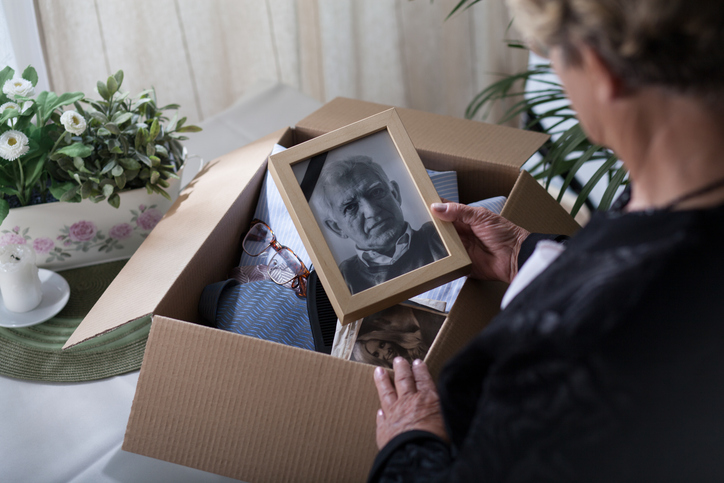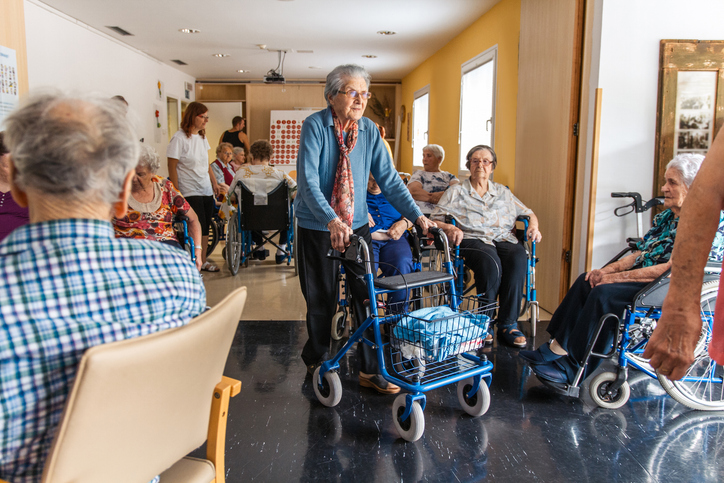Category: Quality of life
Everything You Need to Know About Endometriosis
July 1, 2025

According to the World Health Organization, 10% of women worldwide, or 190 million women, are diagnosed with endometriosis. But the actual number of women who have endometriosis is likely much higher as so many cases go undiagnosed.
Endometriosis is a disease in which the tissue similar to that which lines the uterus begins to grow outside of the uterus, potentially causing pain and other complications. The main symptom of endometriosis is a painful menstrual cycle, but the pelvic and abdominal pain associated with endometriosis may eventually become chronic.
Endometriosis can begin with the first menstrual cycle and last through menopause. Because so many women are dismissed as simply having painful cycles, it’s essential to raise awareness about this condition.
If you think you or someone you know may be suffering through symptoms without a diagnosis, here’s everything you need to know about endometriosis.
What Makes Diagnosis Difficult
Women see seven physicians on average before getting diagnosed, and the average delay for diagnosis is 8.5 years. Because the symptoms of endometriosis can mimic other conditions, such as irritable bowel syndrome, diagnosis is often prolonged, if even diagnosed at all. “Endometriosis is a fascinating, but troubling disease,” says Dr. Hugh Taylor, chief of obstetrics and gynecology at Yale New Haven Hospital. “It’s something that is often missed,” he says.
Another factor that makes diagnosis difficult is that the only way to diagnose someone with endometriosis definitively is through a laparoscopic procedure. Once endometrial lesions are deep enough, some may appear on an ultrasound, CT, or MRI scan. But by then, the stage of endometriosis may be somewhat advanced. Doctors may suspect the disease and clinically diagnose and treat patients for the time being. If endometriosis is suspected, the only way to a definitive diagnosis is through a laparoscopy.
What to Know About Symptoms
Besides having difficult periods each month, other symptoms include pain that becomes chronic throughout the body, digestive irregularities, bladder issues, fatigue, infertility, and mental health struggles. “We’re not talking a little bit of pain here,” says Philippa Saunders, a reproductive biologist at the University of Edinburgh. “People can’t function.”
When it comes to endometriosis, it’s important to understand that the disease is a whole-body issue. “In the past three to five years, there’s been a complete reframing of this disorder as a neuroinflammatory whole-body condition,” says Saunders. “It isn’t just about a little bit of tissue stuck in the wrong place. Your whole body has reacted.”
Because the tissue can grow anywhere outside of the uterus, endometriosis has the potential to spread throughout the body, affecting every major organ system. Many symptoms are caused by the inflammation that occurs because of the disease. This is why a patient may experience bowel issues, even when lesions are absent in the bowels.
Why You Need a Specialist
Even though endometriosis is a gynecological condition, not every gynecologist is extensively trained in diagnosing and treating endometriosis. Because the condition is so complex and largely misunderstood, even the best doctors are not equipped to treat the disorder if they don’t specialize in it.
The Endometriosis Foundation of America recommends finding a specialist that has exceptional surgical skills, access to modern techniques and equipment, a current understanding of various treatments, and an openness to complementary approaches. Since there is no known cause or cure for endometriosis yet, the best way to manage the condition is through ongoing treatment with a trusted doctor.
“For women, it can be validating to learn that all of their symptoms have an explanation and that we have effective treatments,” says Taylor. If you suspect endometriosis, you should ask your healthcare team, including your general doctor, OB-GYN, and pelvic floor therapist, if they have any recommendations for specialists in your area.
Listen to your body and remain committed to finding a doctor who will listen to you, too. Trust your intuition and ask yourself if a doctor is listening to you, acknowledging your symptoms, and addressing your concerns.
Treatment Options
If endometriosis has been confirmed through another laparoscopic procedure or it is suspected, an excision surgery becomes an option in reducing pain and preventing further complications. Excision surgery at the root of a lesion, rather than ablation, is the best way to prevent the lesions from returning.
However, the removal of lesions is not a cure. A study in the International Journal of Obstetrics and Gynaecology found that 62% of women with endometriosis had a second surgery within two years, while half had a repeat surgery within 5.5 years.
The recurrence rate is why maintaining the condition is the main component of ongoing treatment. Make sure you have a doctor who is knowledgeable in hormone therapy, is monitoring your symptoms closely, and making lifestyle recommendations. For instance, plenty of movement and exercise, particularly pelvic floor therapy and Pilates, reduce recurrence and symptoms, while a plant-based anti-inflammatory diet does the same.
If you are diagnosed with endometriosis, then prioritizing your overall health will be the best thing you can do to manage the condition. Do everything possible to reduce your symptoms, including working with your doctors. With Insureyouknow.org, you may keep all of your research, medical records, and financial documents in one place, making the management of your endometriosis less overwhelming.
What to Do After a Loved One Dies
June 15, 2025

The loss of a loved one is one of life’s most stressful events. Almost ninety percent of people over the age of 16 have experienced grief, but 57% of Americans have experienced a significant loss within the last three years.
Mourning is the natural process someone will go through when a loved one passes away. Though many initially gather with friends and family to share the loss, the mourning process is personal and may last months or years.
Here are some gentle steps to take when processing the loss of a loved one.
Know the Symptoms of Grief
Dealing with death is something most people would rather avoid altogether, but grieving isn’t something to put off. Your grief is likely to be felt physically, emotionally, and psychologically. Allowing yourself to move through your feelings is integral to the process.
Give Yourself Time
Now is the time to take care of yourself. You don’t need to put an expiration date on your grieving. “Some people grieve for years, and while they become more functional as time goes on, they may still get hit out of nowhere with grief-related feelings,” says Dr. Judy Ho, host of the podcast Supercharged Life.
“Grief isn’t linear; it’s more circular. You may feel like you’ve accepted the loss, then something happens months later, and you circle back to denial,” says Ho. However long it takes you to begin feeling better is unique to your situation. So be gentle with yourself as you experience waves of mourning.
Routine is Everything
It is essential to develop and stick to a new routine. Many activities will feel different, and it’s okay to make changes accordingly and try new things. However, sticking to some of what’s normal for you can also be a great comfort. “Grief has a way of rocking our sense of safety, but routine creates stability, which often codes as safety,” says Dr. Anita Robinson, author of The Gift of Grief.
Lean on Your Support System
When a loved one dies, it affects everyone in their circle. “Don’t manage grief alone,” says Melissa Robinson-Brown, a clinical psychologist in New York. “If there were ever a time to lean on family and friends, this would be it.” Talk to those you feel most comfortable with and let them know what you’re experiencing.
While everyone finds their way to cope, it can be valuable to share the loss of someone and grieve together. People should be open and honest with one another and not try to hide their feelings. Because the roles of family members may change, it’s best to communicate with one another moving forward.
Bereavement Groups and Counseling
It may be helpful to join a bereavement support group. Bereavement means the state of having been deprived of something or someone valued, primarily through death. Being around others experiencing the same loss level helps many feel less alone. Hospices, hospitals, and community organizations will all have more information on support groups in your area.
One-on-one counseling can be an essential part of losing a loved one and processing that loss in a healthy way. Death can come as a great shock, and mental health counselors can offer a safe place for you to resolve those emotions. Through hospice, bereavement care is even provided for up to 13 months.
Experiencing the loss of a loved one can be a painful process. Focusing on the joy the relationship brought to your life is a great source of solace during the most emotional moments. With Insureyouknow.org, you may store your loved one’s records for safekeeping so that when it’s time to handle the logistics of someone passing, you’ll be up for the task.
Everything to Know if You Want to Live and Age in Place
June 1, 2025

Most people would prefer the comfort of having their own space as they age. Studies show that as many as 90 percent of adults wish to remain home. Living in place, sometimes known as aging in place, also equates to maintaining independence for as long as possible.
“For many of us, home is comfort. There’s a history we are familiar with: It’s family, friends and neighbors. It reflects our culture and our community,” says Emily Johnson, a licensed clinical social worker. “As we begin to lose control of other aspects of our life, staying in our home says, ‘I can accept help, but I am still running the show.”’
Remaining home as you grow older requires careful consideration and thoughtful planning. Here’s everything you need to know about living and aging in place.
Make Your Plans Now
The best thing to do if you want to age in place is to plan for it now while you are still able to. Consider what kind of help you may need now or want in the future. Planning ahead gives you time to set up your home and budget for the required changes and services.
Be sure to factor in any health conditions you or your spouse may already have. Think about how that condition may make it difficult to care for yourself independently. Then, talk to family and friends about what level of support they can offer. Ensure everyone’s realistic and plan to revisit the issue periodically over time.
On average, an adult over the age of 65 falls every second in the U.S. You can prevent accidents at home with these simple safety measures:
- Apply contrasting colored electrical tape on stair landings.
- Remove throw rugs without grip from the home.
- Clear away clutter, including loose cords.
- This includes the outdoors; porches and walkways should be swept and shoveled.
- Ensure the home is well-lit and place night lights in halls and bathrooms.
- Always use handrails and install grab bars in showers and tubs and next to the toilet.
- Always wear proper-fitting supportive shoes in the house and outdoors.
As conditions change, you may need to reassess your home regularly for potential hazards. To troubleshoot, ask a family member or friend to complete a walkthrough with you for a second set of eyes.
Budget For Services
Home-based care services can be used in short-term situations, such as during recovery from surgery, or in the long term for those who need ongoing help. In addition to healthcare services, people may need help with chores, meal delivery, or transportation for doctor’s visits.
While home-based services can be expensive, they may cost far less than moving into an assisted living facility. The Eldercare Locator is a resource that connects people to caregivers through local support services.
People often rely on various payment sources, including personal funds, long-term care insurance, and government programs. For more information on government-based healthcare and financial assistance, visit USA.gov.
Prioritize Your Long-Term Health
If your goal is to stay home, then make your overall health maintenance a top priority. Stay current with your doctor’s visits and set alarm reminders for medications.
Make a plan to maintain body strength as you age, powerful legs to support balance and assist you in getting up safely from a seated position. “Strength, balance, and flexibility exercises are key to preventing falls, which are among the greatest threats to our healthy longevity,” says Scott Kaiser, a family physician and geriatrician.
In addition to scheduling regular exercise into your routine, don’t forget about your mental well-being. “Investing in meaningful relationships is one of the most important things we can do to increase our health, quality of life, and wellbeing,” says Kaiser. Remain engaged in social activities and plan visits with loved ones, including video calls with those who live farther away.
Prepare for the Unexpected
Always be prepared for unexpected events and medical emergencies. “Be proactive,” says Johnson. “Where are there gaps now or barriers to living independently in the future?” For instance, if you have a preexisting allergy or medical condition like diabetes, wearing a medical alert ID bracelet is a simple precaution. A wearable electronic monitor that can alert emergency personnel in the event of a fall is another easy measure to implement.
Even if the plan is to stay at home for as long as possible, there may come a time when that’s no longer safe. The decision about whether or not to move away from home is a difficult and emotional one to make.
It’s best to mentally prepare for that possibility now while there’s still time to have some control over where you’ll go. Learn as much as possible about the available housing options and include loved ones in the search.
Living in place is an attainable goal with the right amount of forethought. At Insureyouknow.org, you may store all of your financial and medical records in one easy-to-review place. By staying on top of your budget and health needs, you will have already taken care of the most critical components of your aging-in-place plan.
Choosing the Right Care Center for Loved Ones
May 15, 2025

Moving a loved one into a care facility is an important decision that requires careful consideration. Choosing the right one takes in-depth research to determine if it’s a good fit for the individual’s needs. There are nearly 31,000 assisted living centers in the U.S. The first step in finding care is understanding the difference between types of facilities and whether they can provide the level of attention the patient needs.
Types of Care Centers
A nursing home provides around-the-clock medical care for individuals who will likely remain there until their passing. These are meant for individuals who can no longer care for themselves independently or be cared for by their loved ones at home. A skilled nursing facility may be intended for a short or long period. Still, it provides a higher level of medical attention and is usually for those recovering from surgery or an illness.
Independent living and assisted living centers are for those who need less intensive medical assistance but still require some level of care. A continuing-care center can serve as an intermediary between assisted living and a nursing home. For individuals who need 24/7 care and supervision due to Alzheimer’s or dementia, there are memory care centers that specialize in those specific needs.
Paying for Long-Term Care
Many people are unaware that there is no federal assistance available for long-term care costs. There is one exception in which Medicare will pay for the first 100 days in a nursing home or skilled nursing facility if the patient has been hospitalized for at least three consecutive days within the last year before needing to be transferred to a care facility.
Paying for care can be a significant issue for families as it can become costly. “Nursing homes are one of the most expensive levels of care,” says Amie Clark, a senior care expert. “And most people don’t have that kind of money.”
Long-term care insurance policies may be a wise, proactive investment, but they can also be expensive. In most cases, people pay privately or out of pocket until their resources are used up. According to the NCHS, 62% of nursing home residents use Medicaid as their payment source.
Other Factors to Consider
Unfortunately, nursing homes face their fair share of challenges, such as being understaffed or dealing with infectious outbreaks. This is why it’s so important for families to do their due diligence in researching facilities and not feel rushed into making a decision.
Medicare offers an online resource to find and compare nursing homes, hospitals, and other care facilities in your area. It uses a five-star rating system and provides information about each nursing home, including vaccination rates and inspection reports. Another helpful resource is the Nursing Home Inspect, which compiles nursing home inspection reports.
Experts suggest not relying on ratings alone and focusing on a facility’s staffing, saying that nothing beats an in-person visit.
Here’s what to do when you’re on-site:
- Speak with a range of employees, from administrators to activity managers to culinary directors.
- Take note of response times.“How long does it take for call lights to be responded to?” says Shannon Gimbel, manager of the ombudsman program for Denver’s Area Agency on Aging. “Are residents standing in hallways waiting for medication?”
- Notice the patients’ level of hygiene. “Listen in the hallways,” says Tony Chicotel, attorney for the patient advocacy group California Advocates for Nursing Home Reform. “Look at the hair, clothing, teeth, and fingernails of the residents.”
- Try the food. Sit in the dining hall with other residents and observe the interactions between patients and staff.
- Ask about the activities offered to residents and consider whether or not they will be intellectually stimulating.
While it’s best to find a care facility that’s close to you, traveling farther for the best fit may become necessary.
Once you determine what kind of facility your loved one needs and make payment plans, then you should do your research and take the time to visit all of the centers you’ve narrowed down on your list. With Insureyouknow.org, you may compile your research, keep track of finances, and store your loved one’s medical records in one easy-to-review place. While it will take some research, finding the right place will provide you with invaluable peace of mind.
How Much Sleep Do You Really Need?
May 1, 2025

You might pride yourself on burning the midnight oil or think you’re functioning fine on five or six hours of sleep—but your body would likely disagree. According to the CDC, a third of all adults in the United States report that they don’t get enough sleep, and that’s troublesome since the benefits of a good night’s rest are numerous. Sleep isn’t just downtime—it’s when your brain files memories, your body repairs itself, and your mood resets.
So how much sleep do you actually need to feel your best? It’s not a one-size-fits-all answer. While many people are under the assumption they can operate on less than seven hours of sleep a night, research shows that seven hours is just the bare minimum needed.
Here’s everything you need to know about how long you should aim to sleep nightly.
Seven Hours Isn’t Exactly the Golden Rule
According to the CDC, the average adult between the ages of 18 and 60 needs at least seven hours of sleep. “Some people need less than seven hours, while others might need more,” says Eric Zhou, a psychologist at the Division of Sleep Medicine at Harvard Medical School.
While people usually focus on the amount of sleep they need, they forget to consider the quality of sleep they’re having. For instance, you may go to bed at 11 p.m. with an alarm set for 6 a.m., but when do you actually fall asleep, and are you staying asleep all night?
“Instead of focusing exclusively on the number of hours we sleep per night, we should also consider our sleep quality,” says Zhou. It’s about the time you spend in bed every night, but it’s more about the amount of uninterrupted deep sleep you’re experiencing nightly.
Wearable sleep trackers, such as the Oura Ring, Fitbit, or Apple Watch, can provide valuable insight into your patterns and help you develop better sleep habits.
Women May Require More Sleep
The traditional estimate of nightly seven to nine hours of sleep is based on studies that only involved men. This has recently led many to wonder whether or not women need more sleep than men, and several factors suggest they may.
Since women are often caregivers, they are wired to multitask and use more of their brain, while they also report higher levels of stress. This mental exhaustion alone could account for them requiring slightly more sleep every night.
The other factor is hormonal, depending on where they are in their cycle each month, as well as during pregnancy and even after menopause. For instance, the hormone progesterone, which peaks at different times, is a relaxing hormone and often leads to drowsiness.
While not everyone agrees, many health professionals are beginning to recommend more sleep for women, who probably need at least eight hours of sleep a night.
Factoring in Age
The younger you are, the more sleep you need, especially when the body is growing or going through major changes. A newborn needs up to 17 hours of sleep a day, while a teenager between the ages of 13 and 18 needs up to ten.
As you age, melatonin production, which is the sleep hormone, declines. The result of less melatonin is waking up earlier or waking up throughout the night. Once over the age of 61, getting the recommended amount of nine hours of sleep can become more challenging.
How to Get a Good Night’s Sleep
Consistency is key for a good night’s sleep. Try maintaining the same time window between lying in bed and waking up. This works because the body recognizes routine and can be trained to sleep within a specific time frame. “People with good sleep quality often have a predictable sleep window where their sleep occurs,” says Zhou. “Good sleepers are likely to sleep around the same number of hours and stay asleep through the night.”
Physical activity during the day also influences how well you sleep at night. The more activity you incorporate into your day will directly correlate to how much sleep your body needs and therefore, how tired you’ll be by bedtime. “Activity increases your sleep drive,” says Dr. Michelle Drerup, a sleep medicine psychologist. “It’s important to develop exercise as a habit. Pick a time of day that works for you and exercise at the same time every day.”
Refraining from eating two to four hours before bedtime can also help. When we eat, the body must switch gears to digestion, so when you eat right before bed, you must focus on digesting that food and cannot fall into a deep sleep. Eating before bedtime robs your body of its capacity to concentrate on the work it does while you’re sleeping.
The same rule applies to nightly screen time. Studies show that two or more hours of screen time in the evening can disrupt the rise in melatonin you need to fall asleep. Turn devices off at least one hour before bedtime, and replace scrolling with reading a book, taking a bath, or meditating. If you must use your phone at night, reduce your blue light exposure by turning down the brightness or switching to nighttime mode in the evening.
Building a routine that you can stick to ensures the right amount of sleep every night is possible. With Insureyouknow.org, you can store your medical records in one easy-to-review place. The effort you put into a good night’s rest will show in time.
Celebrate Earth Day with Five Simple Ways to Protect the Planet
April 15, 2025

Twenty million Americans celebrated the first Earth Day in 1970, and by 2020, that number had grown to over one billion people worldwide. April 22 marks a moment for us to ask what we can do to help the environment. A quick dip into the internet can leave us feeling overwhelmed, but there are things that we, as individuals, can do to make a difference. Here’s a quick list to get you started:
Eat Sustainable
We often think of eating sustainably as difficult or expensive. However, current research shows that what you eat can be as or more important than where your food was produced. While food production leads to 25% of the world’s emissions, transportation accounts for less than 10% of this amount. Thus, avoiding highly intensive foods like beef can make as much of a difference as joining a CSA (Community Supported Agriculture) program which supports local family farms by committing to purchasing produce and meats grown on the farm. Another great alternative is to take advantage of home delivery services that bring imperfect produce to your door, reducing the amount of waste from supermarkets.
Mending and Upcycling Clothing
Each year, 92 million tons of clothing get deposited in landfills. This fact alone turns mending your clothing into a smart way to help protect the planet. A quiet evening spent darning socks or replacing a shirt button can be enjoyable, but new trends are transforming mending into a fashion statement. Kate Sekules, author of Mend and a clothing mender, states that noticeable repairs used to be despised. “These days, fashion is quite in love with imperfection and deconstruction and patching,” she explains.
A quick tour through your closet will reveal pieces that can be upcycled for a new look and garments that can be donated instead of tossed. Research your local area organizations and schools for clothes closets and thrift stores that will recycle your attire. Even sneakers can get a new life through nonprofits like GotSneakers with the added value of keeping old shoes out of the landfill.
Walk More & Drive Less
Transportation is the source of the largest section of greenhouse gas emissions. One great way to reduce the amount of driving is by combining trips. Also known as trip-chaining, gathering up errands and doing all of them on one more extended trip saves gas and time. Win-win!
Reduce Plastic Usage
These days, most store products are wrapped in some form of plastic packaging. Eliminating it from our lives feels almost impossible. The Zero Waste Movement seems like a great idea, but challenging to implement. Reducing waste by 10% however feels achievable. “Zero waste isn’t an all-or-nothing proposition,” says Anne-Marie Bonneau, author of The Zero Waste Chef. “Some of the changes necessary to reach that 10 percent goal, which just about everyone can do, won’t hurt one bit.”
Some quick tips include using cloth bags when purchasing loose produce and bringing your own glass or metal containers to refill with bulk items.
Implementing just one of these strategies begins your journey to protecting the planet with a tiny step. This will hopefully result in significant change for the Earth.
InsureYouKnow.org
Half of all recyclables collected in the US are made up of paper, and most often paper used to document sensitive information gets shredded and burned. InsureYouKnow.org can help you get started by assuring secure and safe storage for your digital records. Storing this information digitally and shifting billing and other communications from paper to electronic means reduces paper use at the source.
Making Friends at Any Age: Why It’s Never Too Late
April 1, 2025

As you get older, you have more responsibilities and are busier than when you were younger, so it may seem like you have less time to make friends. Due to family and professional responsibilities and eventually retirement, people only go to a handful of locations outside their home.
“People make friends in all stages of life,” says Saba Lurie, licensed marriage and family therapist in Los Angeles. “Maintaining and making new friends as we age may be more difficult because we’re spending less time going to places such as work, religious and community centers.”
By being willing to connect with new people and stay in touch with our friends, developing a rich social network is possible as we age and is beneficial to our health.
The Liking Gap and Acceptance Prophecy
When people meet others for the first time, they perceive themselves to be less likeable than they are. Researchers call this phenomenon the “liking gap.” That means that when you meet people for the first time, they will likely enjoy your company more than you realize. If you keep that in mind, it may be easier to introduce yourself to new people and feel more confident in how you’re perceived.
If you believe that others will accept you, then the odds of you being accepted by them rise. Conversely, if you think other people won’t take you upon meeting you, the odds increase that they won’t. This is called the “acceptance prophecy.” So if you believe they’ll like you when you meet someone new, they probably will.
Remembering the liking gap and acceptance prophecy when interacting with others for the first time should empower you and give you the courage to put yourself out there more often.
Where to Meet New People
No matter what kind of friend you’re looking for, the best place to start is with what interests you. If your job is also a passion, you may want to try connecting with your coworkers at work and off hours.
But if your job is simply what you do and not necessarily what you love doing, consider incorporating more hobbies into your schedule. That could be joining a gardening meetup, running club, or pickup basketball game.
Outside of work and other hobbies, consider your identity. Are you a mom of young children, for instance? Then you may want to find a mommy and me playgroup or join the parent-teacher association at your child’s school.
Putting yourself around others with similar passions, interests, or lifestyles makes it easy to find things to discuss and relate to each other. “Take an art class, volunteer at the library. Develop some regular routines,” says Lurie. “You need to take a step in showing up.”
Companionship Versus Deep Connections
It’s important to remember that there are different kinds of friends. Some friends are good companions while at work or as a workout buddy at the gym. These types of connections can become more substantial in time, but if not, that doesn’t mean that these types of companions are less valuable. People who have more companions and social interactions with new people are happier than those who have fewer as well as being happier on days when they have more encounters. “These minimal social interactions give us something important that we missed during the pandemic: novelty,” says Gillian Sandstrom, senior lecturer in psychology at the University of Sussex. “We learn surprising things when we have unplanned encounters and conversations with people.”
Most people only form deep connections with a handful of people in their lifetime. These are the relationships that stand the test of time and distance. Many people with this kind of connection can go years without seeing each other but maintain closeness by checking in regularly with one another. With long-term friendships such as these, it’s important to work at fostering them, whether that’s making the point to see them in person when you can or by staying in regular contact with them through texting, phone calls, and video chats.
Keeping Friends Close During Hardships
Sometimes, life gets challenging or overwhelming. Many people will self-isolate when the going gets tough instead of reaching out to those around them, but the hard times hold friendship benefits. Reaching out to a friend when you need support can strengthen that bond, while feeling connected to others alleviates stress. Researchers have even found that people judged a hill to be less steep when accompanied by a friend.
While making time for friends, whether old or new, may seem like yet another to-do on an already overflowing plate, feeling connected to others more often may help you feel like your life is more manageable. With Insureyouknow.org, you may keep track of your calendar, social obligations, and other essential appointments. By keeping your schedule organized, you can focus on showing up and enjoying the company of your comrades.
How to Prepare for College Living: A Survival Guide for Incoming Students
February 15, 2025

Congratulations! You’ve been accepted into college, and soon, you’ll embark on one of the most exciting adventures of your life, along with 16 million others. But before you start dreaming about campus life, late-night study sessions, and newfound independence, there are some practical steps to ensure a smooth transition. From dorm essentials to financial planning, this guide will help you prepare for college living.
1. Master the Art of Budgeting
Living on your own means managing your finances wisely. Here’s how to stay on top of your budget:
- Create a Budget: Track your expenses, including tuition, rent, food, transportation, and entertainment.
- Use Budgeting Apps: Apps like Mint, YNAB, or PocketGuard can help you stay organized.
- Open a Student Bank Account: Many banks offer students accounts with low or no fees.
- Look for Discounts: Your student ID is your best friend—use it for travel, entertainment, and shopping discounts.
2. Pack Smart: The College Essentials Checklist
You don’t want to arrive at college and realize you forgot something crucial. Here’s what to bring:
- Dorm Room Must-Haves:
- Bedding (twin XL sheets, comforter, pillows)
- Storage bins and organizers
- Desk lamp and power strips
- Laundry hamper and detergent
- Shower caddy and flip-flops
- Tech Gear:
- Laptop and chargers
- Noise-canceling headphones
- Portable hard drive or cloud storage subscription
- Kitchen Supplies:
- Mini fridge (if allowed)
- Microwave or coffee maker
- Reusable water bottles and utensils
- Emergency Kit:
- First aid supplies
- Medications
- Flashlight and extra batteries
3. Set Up Your Health & Insurance Plan
Make sure you have a solid plan in place for medical needs:
- Health Insurance: Check if you’re covered under your parent’s plan or if your college offers coverage.
- Locate Healthcare Providers: Know where the nearest doctor, dentist, and urgent care clinic are.
- Stock Up on Essentials: Pack prescription medications, vitamins, and a basic first-aid kit.
4. Learn Basic Life Skills
College is a time to gain independence, so mastering basic skills will help you thrive:
- Cooking Basics: Learn how to make simple meals to save money and eat healthier.
- Laundry 101: Know how to separate colors, use detergent, and read washing machine settings.
- Time Management: College life is busy—use planners or apps to manage assignments and social activities.
5. Prepare for Roommate Life
Sharing a living space can be a challenge, but good communication helps:
- Set Boundaries Early: Discuss sleep schedules, cleaning duties, and guest policies.
- Be Respectful: Small gestures, like cleaning up after yourself, go a long way.
- Resolve Conflicts Maturely: Address issues directly and respectfully to maintain a positive environment.
6. Get to Know Campus Resources
Colleges offer plenty of support services—take advantage of them!
- Academic Support: Visit tutoring centers and writing labs.
- Mental Health Services: Many colleges offer free or low-cost counseling.
- Career Services: Start networking and building your resume early.
- Student Organizations: Join clubs to meet new friends and enhance your college experience.
College is a time of growth, challenges, and unforgettable experiences. By planning ahead, you can make the transition smoother and set yourself up for success. Embrace the adventure, stay organized, and don’t hesitate to ask for help when needed. You’ve got this!
InsureYouKnow.org
College graduation prompts transitioning from a school-based existence to one replete with adult responsibilities. By preparing for the unforeseen future, college grads who do their homework and keep their records at insureyouknow.org, can begin living their lives to the fullest.
Medicare Grocery Allowances: Who Qualifies and Is it Worth it?
January 15, 2025

In 2020, the Medicare Advantage expanded coverage benefits for those with chronic conditions, such as cancer, autoimmune disorders, diabetes, end-stage renal or liver disease, heart disease, and more. The coverage expansion is referred to as the special supplemental benefits for the chronically ill or SSBCI. Some additional benefits include food allowances and prepared meals, but in some instances, they may even include over-the-counter medications, transportation, and in-home support services.
If you’re interested in receiving a grocery allowance or meal benefits or need food assistance, here’s everything you need to know about the additional coverage.
How the Medicare Grocery Allowance and Meal Benefits Work
Grocery allowances and meal benefits are not the same. If you qualify for grocery allowances, they are issued through prepaid debit cards on a monthly or quarterly basis. While the grocery allowance varies by state, it is usually $50 each quarter.
Under the CHRONIC Care Act, as of 2020, Medicare Advantage plans could also provide meals anytime to keep eligible recipients from needing hospitalization. Meal benefits are often more popular than grocery allowances, but it’s usually only offered for a limited amount of time, which is typically four weeks after a hospital stay.
Knowing Which Plans Offer Food Assistance
Not all Medicare Advantage plans include food allowances, so it’s important to determine if you qualify before choosing a plan. Traditional Medicare Part A and Part B and Medicare supplement plans, which are meant to supplement gaps in coverage, do not offer a grocery allowance. Some Part C Medicare Advantage Plans do offer grocery allowances and meal benefits, such as special needs plans or SNPs and dual-eligible special-needs plans D-SNPs. D-SNPs are meant for Medicare members who are also enrolled in Medicaid and who have a chronic condition. Those with Medicare Advantage plans who are disabled or who have a low-income subsidy or LIS may also be eligible to receive grocery benefits.
The CHRONIC Care Act of 2020 gave Medicare Advantage plans the ability to offer non-medical benefits such as funds for groceries. “Therefore, the Medicare Advantage plan can decide if they want to provide those benefits, and those benefits have to be designed only for the chronically ill,” says Alexandra Ashbrook, director of the Food Research and Action Center. “The non-medical services have to be targeted to people who have at least one chronic health condition, such as those at risk of hospitalization or some other adverse health outcome requiring intensive care coordination,” she says.
Qualifications for the grocery and meal benefits vary by plan, so it’s important to check with the plan’s provider to see what they offer and if your health condition qualifies. Choosing a plan based solely on food allowances isn’t the best approach over the long run. So, even if the plan offers a grocery or meal benefit, it may not justify what you pay for the plan. Whether or not the plan covers medical needs should always be the priority. Take into account every benefit the plan offers before making a decision.
What to do if You Don’t Qualify for Medicare Food Allowances
There are still other options for those who do not qualify for the grocery allowance through their Medicare Advantage Plan. Low-income seniors 60 or older can apply for food assistance through the Supplemental Nutrition Assistance Program or SNAP. Many people don’t even realize that they qualify for these benefits. “Unfortunately, only about 48% of eligible older adults are participating in SNAP,” Ashbrook says. “That’s a really important gap that health care providers and health systems could help to close before looking at any of the other additional food programs.”
Those who are 60 or older and have an income below 185% of the federal poverty income guidelines may also qualify for the Senior Farmers’ Market Nutrition Program SFMNP or the Commodity Supplemental Food Program or CSFP. The SFMNP provides coupons for fresh fruits and vegetables, which can be used at farmers’ markets and community farms, while the CSFP is a monthly package of healthy food that the USDA distributes to local agencies for participants to pick up. If eligible, some states even offer package deliveries.
To find out if you are eligible for SNAP or either of these additional programs, you may fill out an application online. If you’re a veteran, for instance, you may be more likely to qualify for USDA food assistance programs. Even if you are not eligible for Medicare grocery allowances, SNAP, or other supplemental programs, you still have options. Meals On Wheels is another program designed to help low-income seniors access prepared meals. The meals are provided on a sliding scale based on a recipient’s income to make them an affordable option for those in need.
If any food assistance will help you, then exploring every available benefit will pay off. Whether it’s a Medicare food allowance or a USDA-based food assistance program, helping purchase and prepare healthy foods can go a long way in improving the quality of your everyday life. With Insureyouknow.org, you may keep track of your applications, health records, and grocery budgets in one easy-to-access place for all your meal planning needs.
The Health Benefits of Even the Shortest Vacations
December 15, 2024

Just like an athlete benefits from breaks during exercise, vacations are an important part of someone’s well-being. According to a Pew Research Center survey in 2023, nearly half of the U.S. workers surveyed said they take less time off than the paid time off their employers gave them, while globally, eighty-five percent of workers reported that vacations make them feel more optimistic and that regular vacations are important for their overall health.
“Not taking time off from work to go on vacation or simply rest can lead to overwork and burnout,” says Joyce Marter, a licensed psychotherapist. “People should use all the vacation time allotted to them—and sick days should also be used.
If you’ve been feeling the need for a true rest, here’s everything you need to know about getting the most out of even the shortest vacations.
The Right Amount of Time Off
While experts agree that any amount of vacation time is beneficial, three weeks per year may be just the right amount to benefit your health. The European Society of Cardiology conducted a 40-year-long study that found people who take less than three weeks of vacation time per year have a 37% greater risk of premature death, even despite living an otherwise healthy lifestyle.
Another study in 2020 showed that people who split two weeks of annual vacation time into five short breaks had a 24% lower risk of metabolic syndrome. Even the long weekend can come with serious benefits, as those who took a four-day vacation had improved stress-levels for an entire month after returning to work.
Since the positive effects of a trip usually fade after a month of being back home, taking several short trips throughout the year can be more beneficial than one or two long vacations. Plus, the planning process can make you feel happier than the trip itself, so allowing yourself to plan and look forward to a trip more often throughout the year extends the benefits of your vacation time even more.
The Right Way to Travel
Simply going on vacation won’t necessarily result in feeling as though you have a break. “I’ve heard countless times how exhausted people are when they come back from their vacation and feel like they ‘need a vacation from their vacation,’ and that’s because many times we pack so much into a very short amount of time,” says Esther Susag, a travel blogger. “We want to see everything, do everything, and not waste a minute.”
In order to benefit from any amount of time away, it’s important that you provide yourself with the opportunity to actually rest.
Slow travel is a more meditative approach to traveling that allows people to slow down, as the name suggests, and literally stop and smell the roses. “If you want to really unplug and relax without the stresses of traveling then slow travel may be for you,” says Mark Wolters, a YoutTube travel channel host. “You get to unpack your suitcases less, take fewer planes, trains and automobiles and just relax in a destination.
Once you’re on vacation, give yourself the gift of a loose plan. Do some research ahead of time and bring a list of some things you don’t want to miss when you’re there, as well as a few restaurant possibilities. For every day that you’re there, have a half day’s worth of activities planned, giving yourself the time and space in each place to really enjoy the experience.
The Right Companion
In order to have a truly beneficial break, it becomes important to choose the people you vacation with carefully. “Spending time with family and friends are all things that we know can increase well-being and even reduce stress,” says Stephanie Preston, psychology professor at the University of Michigan. “There can be a lot of interpersonal conflict over how you manage the schedule and the priorities.”
While the idea of traveling with extended family, for instance, seems like a good idea on paper, trying to please everyone may prove to be the opposite of a relaxing getaway.
That being said, vacations can also provide the opportunity to bond with your family members and create truly lasting connections with one another. When you plan to travel slowly, your adventure becomes more about being together as a family than about visiting as many attractions as possible. Slow travel provides the space not only to notice your surroundings but also to notice the people you are seeing them with.
The Right Location
Once you decide who to travel with, opt to stay at a vacation rental rather than a hotel. Rentals are rarely at the center of the tourist attractions. This provides both a more relaxing environment to unplug in but also immerses you more deeply into the local experience. Plus, with rentals that have fully stocked kitchens, there’s less of a reason to have to leave and more of an opportunity to stay in and unwind.
The Right Format
Most people intuitively sense that taking a break is good for their health. What’s most important for people to realize is that they don’t need a vacation to have a break. “Many people don’t often have a choice in how much rest is available to them,” says Julia Kocian, a social worker and mental health counselor. “The way society is set up, we treat rest as a privilege, not a right,” she says.
Whether it’s taking a walk in the evening or meditating while you fold the laundry, only you will know what activities best help you to relax. “I view rest as intentionally slowing down or stepping away from an activity, while taking a break can be more active, like going on a walk or stretching,” says Samantha Artherholt, a psychologist and professor at UW School of Medicine. “The goal of any sort of rest or break is it should feel relaxing. You should feel refreshed and better after the break than you did before.”
Work yourself up towards taking more vacation time by finding ways to distribute downtime throughout your day and week. “The biggest thing is giving yourself permission to do it,” Artherholt says. When you learn more about what feels like rest to you, then you can start planning a handful of short vacations for yourself throughout the year. With Insureyouknow.org, you may store your destination research, savings goals, and travel plans all in one place. Remember that planning for your next vacation may be over half of the fun.
